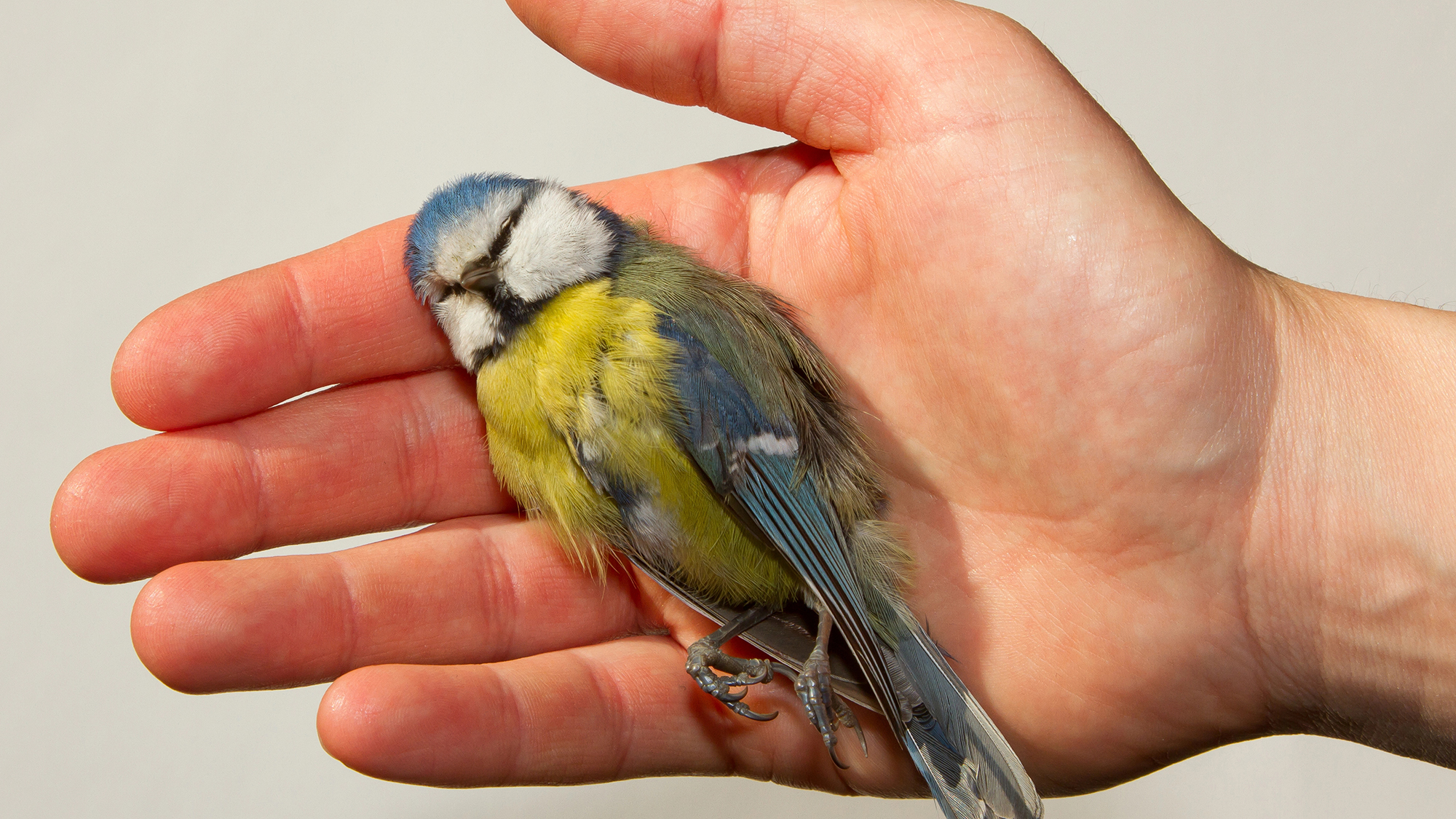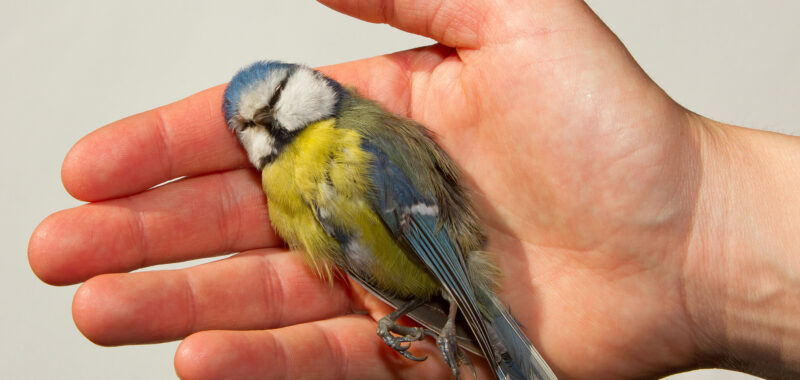
Glass windows are a marvel of human engineering–clear, nearly invisible sheets of sturdy material that let us bring natural light into closed structures. Yet beyond the walls of bright and airy buildings, windows become something else: A threat to wildlife.
Birds don’t understand glass. They haven’t been taught to recognize the structural cues indicating a pane is present, like a rectangular frame or door handle. Instead they often try to fly through it, seeing the open space behind a window as more habitat, or interpreting the reflection in the glass as reality. Don’t judge them too harshly for it, humans run into glass too. But for our feathered, flying friends, the consequences are much more severe.
Windows and glass buildings, particularly combined with the draw and disorientation of artificial light, kill a huge number of birds. And the problem is even worse than we thought. Past estimates of that morality are undercounts, according to new research. It might be tempting to assume that birds found stunned or injured after window collisions and brought to wildlife rehabbers are all making a full recovery. Instead, about 60 percent die–even under the best possible circumstances, receiving care and protection from predators, as outlined in a study published August 7 in the journal PLOS One.
Previous research has come to variable conclusions about estimated avian losses from building strikes. One of the most commonly cited figures, from a 2014 study, suggests that somewhere between hundreds of millions and one billion birds die from hitting windows each year in the U.S. alone. Yet this past analysis, and almost all other investigations of window mortality, relied solely on counting birds found dead next to structures. The new work goes a step further, assessing what happens to a subset of birds that survive the initial impact. Finding that more than half don’t make it leads to an unsettling and unfortunate revised estimate. “Well over 1 billion birds are dying each year in the United States” from building collisions, write the study authors.
“I want to say the numbers were surprising. I want to say I didn’t think it was that bad,” says Ar Kornreich, lead study author and a biology PhD candidate at Fordham University. “But it unfortunately makes sense,” they tell Popular Science.
“Wild animals are tough. They try to survive catastrophic circumstances for as long as they can… But we are losing them even if we don’t see them,” Kornreich adds.
Most birds that hit windows don’t die immediately. One recent observational study found that upwards of 80 percent of birds that collide with glass fly away from the scene, somewhere between 12 and 14 percent are temporarily stunned, and 50 percent of collisions leave no visible evidence. Yet the new research demonstrates that many birds still die in the aftermath of strikes.
Kornreich and their co-authors compiled as much wildlife rehabber data as they could on bird building collisions from a handful of northeastern and mid-Atlantic states reported between 2016 and 2021, in accordance with rehabber licensing requirements. Though their dataset has many gaps, they tracked down more than 3,100 documented collisions involving 152 different avian species. The researchers determined that just 39.5 percent of the birds brought to rehabbers following window strikes ended up released back into the wild, after an average of more than 12 days of treatment. Conversely, 32.1 percent died during treatment, usually within three days of being found. An additional 28.4 percent of birds were euthanized by wildlife rehabbers, who determined that was the most humane course for animals that wouldn’t be able to recover.
“The study addresses an interesting and important question using an underutilized source of information,” says Travis Longcore, an urban ecologist at UCLA and science director of the nonprofit The Urban Wildlands Group. Longcore was not involved in the new research, but has studied light pollution and bird building collisions. He agrees with the new studies’ findings, noting that “our estimates of bird mortality from collisions are probably on the low end.”
“If birds are stunned long enough to be captured and brought into rehabilitation care, even under the best of conditions–where there is food, water, no predators, no street sweepers scooping them up, no people stepping on them–60 percent still die,” says conservation biologist Dustin Partridge, a study co-author and director of conservation and science at NYC Bird Alliance.
Combining these stats with the numbers of birds found injured and excluded from the 2014 study of bird morality, the researchers conservatively estimate that at about 100 million additional birds are being killed by window strikes each year in the U.S.. Yet these new numbers are still potential undercounts, say Partridge and Kornreich, because birds found are just a small portion of the total number of birds that hit buildings and don’t immediately die.
“Looking at rehab cases gives us insight into those hidden deaths that you can’t get from the carcasses,” says Kornreich. It bolsters our ability to accurately estimate deaths, while still not accounting for every single bird collision.
It’s possible that many of the birds that aren’t seen stunned or transported to rehabbers still die. It’s also possible that those taken to rehabbers represent a more seriously injured subset than those that go unnoticed or immediately leave the collision scene, notes Kornreich. “We really don’t know much about those that hit windows and manage to escape,” they say–more observational and tracking research is needed to reveal those longer-term outcomes. And broadly, there are many open unknowns and open questions that this one study doesn’t answer. Their data is incomplete and regional. It’s unclear, for instance, if these Northeast findings apply elsewhere in the country or what factors determine if a bird is brought to a rehabber.
But what we do know is that it’s hard to survive as a bird in the wild–especially one that’s injured or dazed. And for the percentage of birds that are hurt by a window collision but may still appear to perk back up, the study findings are grim.
In addition, the researchers assessed the variables influencing the outcomes of avian window collisions. Among other things, they found that bigger birds have a higher likelihood of survival, deaths and treatment time vary by season, and that head trauma and concussions were the most commonly reported injuries–potentially helping to inform and prioritize future wildlife treatment.
Despite the fact that they can’t save every bird brought to them, “wildlife rehabbers are a lifeline for wildlife in need, birds and otherwise,” says Kornreich. “They are very much part of the solution. They do have a significant impact on populations, but also on individual lives, which has its own value.”
Yet the findings emphasize that rehabbers can’t be the only solution. “It brings home the fact that prevention is key,” says Longcore. And prevention is possible.
Birds face a myriad of challenges in the modern day world, and their populations are declining rapidly. Even once common species are experiencing losses, according to a 2019 study of North American avifauna. There’s climate change, habitat loss, and yes–cats. Feral and outdoor cats have led to the total extinction of 40 bird species, and are thought to be the biggest driver of human-caused bird mortality. One analysis estimates that cats kill up to 4 billion birds a year in the US. Windows come in as a close second on the avian mortality charts. And arguably, the problem of windows is the easiest of all the threats to address.
Proven strategies, like bird safe glass and retrofits with window films, tape, and correctly applied stickers all minimize strike risk, with essentially no downsides. Many birds migrate at night and are drawn towards the artificial light of human cities, says Longcore. Lights out initiatives during migration season can prevent birds from being attracted to dangerous obstacles in the first place, saving millions.
And everyone can play a role in helping–whether you’re in the city or the country. By virtue of the amount of space that sprawl takes up and the amount of low density development, most bird collisions likely happen in suburban and rural areas, filled with low rise buildings and residential homes, says Longcore.
If you want to create a safer flying environment, “what you need to do is make glass visible to birds,” says Partridge. Any film or application that results in a pattern spaced a maximum of two-inches apart works best, for retrofitting existing windows, he notes. Screens are also a great preventative barrier. And “it’s really important to turn lights off, especially during migration,” he adds. Switching off your own home lights in the spring and fall, or drawing curtains as soon as it’s dark out, are important individual steps. Advocating for your community to institute a lights out program for commercial buildings can bring change at the larger scale.
“Birds are a hugely important part of our environment,” says Kornreich. They eat pests, pollinate plants, spread seeds, and clean up carrion–among other helpful activities. They’re also a delight. “Birds have been a source of inspiration and joy for humanity for thousands and thousands of years,” they add. If we want to see birds flying far into the future, we’ll have to reframe how we see our windows.

